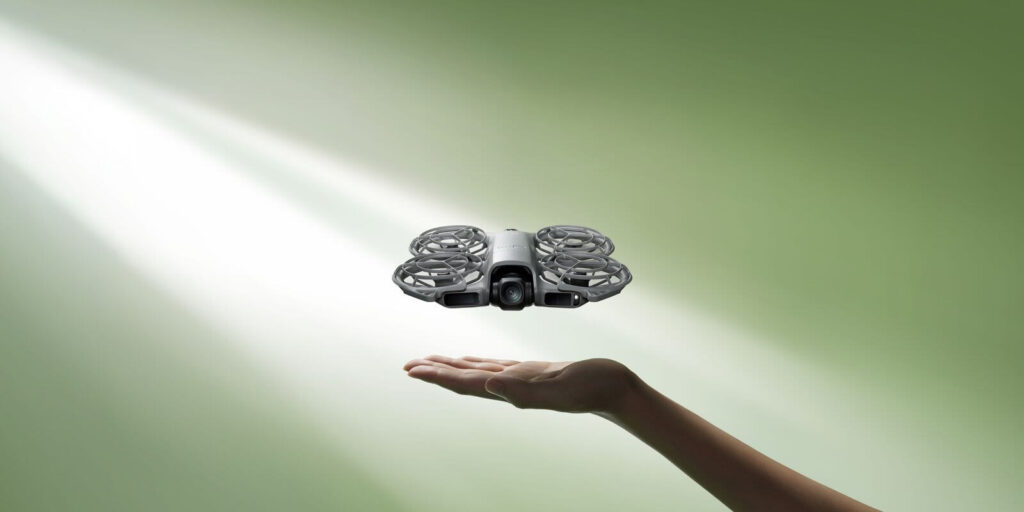
The DJI Neo 2, a compact and lightweight drone, is making waves in the world of aerial photography and videography. Released recently, this innovative device boasts omnidirectional obstacle sensing, gesture control, and enhanced ActiveTrack capabilities, making it ideal for capturing dynamic activities such as running and cycling. According to DJI, the Neo 2 is designed to cater to beginners and seasoned drone enthusiasts alike, offering an easy-to-fly experience perfect for family outings, outdoor sports, and travel adventures.
Equipped with a small onboard display, the Neo 2 allows users to easily select shooting modes. Launching the drone is as simple as pointing it at oneself and pressing the take-off button. Once the desired footage is captured, the Return-to-Palm feature ensures a safe and steady landing back into the user’s hand. Gesture Control further enhances the user experience, allowing direction and proximity adjustments with simple hand movements, eliminating the need for a remote controller.
Advanced Features and Capabilities
The DJI Neo 2 is packed with features that set it apart from its predecessors. Notably, it supports voice control, enabling users to issue flying commands via smartphone or Bluetooth headphones. For those requiring extended range, the Neo 2 can be paired with the DJI RC-N3 remote controller, achieving a maximum video transmission distance of 10 kilometers.
The drone’s camera is a standout feature, equipped with a 12MP, 1/2-inch CMOS sensor, an f/2.2 aperture, and a high-performance image processor. This setup ensures clearer, low-noise footage, stabilized by a new two-axis gimbal. The integration of DJI’s ActiveTrack and SelfieShot allows for smooth, hands-free shooting, automatically framing subjects from start to finish. With 4K video recording capabilities at up to 100fps, users can create stunning slow-motion or vertical videos.
Innovative Tracking and Shooting Modes
One of the Neo 2’s most impressive features is its enhanced tracking performance, which offers faster response and improved stability. This capability is crucial for capturing smooth and steady footage during high-speed activities like running or cycling. The drone can track subjects at speeds of up to 12 meters per second in open areas, utilizing eight-direction tracking for more natural follow shots.
In complex environments, the Neo 2 can switch to rear tracking mode, maintaining focus on the subject. The new SelfieShot feature allows users to capture solo or group moments hands-free, with options for waist-up, full-body, and long shots. The drone also supports intelligent shooting modes such as Dolly Zoom, QuickShots, and MasterShots, enabling users to create professional-quality videos with ease.
“The Neo 2’s omnidirectional monocular vision system, combined with forward-facing LiDAR and a downward infrared sensing system, detects obstacles in real time for safe, confident flying.” – DJI
Safety and Storage Enhancements
Safety is a priority for DJI, and the Neo 2 reflects this with its integrated propeller guard design, providing all-around protection for beginners. The drone’s versatile flight capabilities, enhanced hovering, and positioning make it suitable for navigating challenging environments, whether indoors, near buildings, or over water and snow.
With level 5 wind resistance, the Neo 2 can withstand adverse weather conditions, offering up to 19 minutes of flight time. Its 49GB internal storage capacity allows for extensive video recording, supporting up to 105 minutes of 4K/60fps video, 175 minutes of 4K/30fps video, or 241 minutes of 1080p/60fps video. Users can transfer footage to the DJI Fly app via Wi-Fi at speeds up to 80 MB/s, streamlining post-production and sharing processes.
Implications for the Drone Market
The release of the DJI Neo 2 represents a significant advancement in consumer drone technology, offering features that were once exclusive to professional-grade equipment. Its user-friendly design and advanced capabilities are likely to attract a wide range of users, from hobbyists to professional content creators. As drones become increasingly integrated into various industries, the Neo 2’s innovations could set new standards for what consumers expect from personal drones.
Looking ahead, the continued evolution of drone technology promises to further enhance the capabilities and accessibility of these devices. As DJI and other manufacturers push the boundaries of what’s possible, the future of aerial photography and videography looks brighter than ever.





